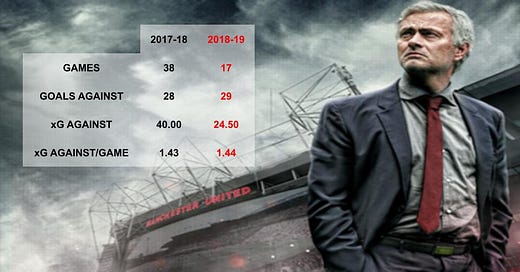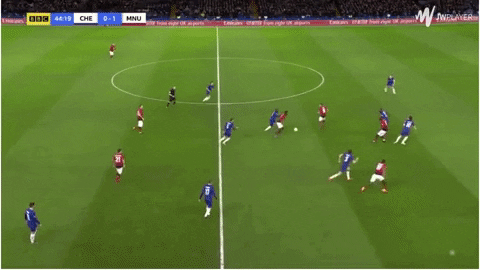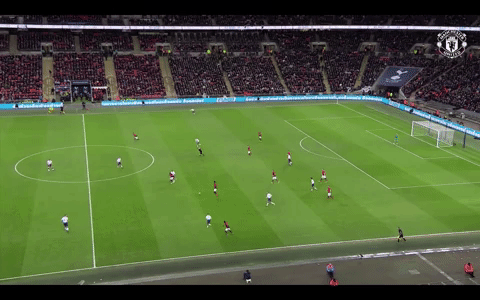Note: this is part one of a five part series on Ole Gunnar Solskjaer and the distinctly different tactical ‘eras’ he’s had during his two years in charge of Manchester United.
Please read the introduction for more information and if you haven’t done so yet, subscribe for more of Kwest Thoughts.
*Throughout this series advanced stats come from @statsbomb provided by @fbref. xPTS and some xG numbers coming from understat will be noted
Period: December 2018 (Cardiff away) - February 2019 (PSG home)
Base Formation: 4-3-3
Most Benefitting Player: Paul Pogba
Second Standout Player: Marcus Rashford
Ole Gunnar Solskjaer’s great reign as Manchester United’s caretaker manager is classically misremembered as being from the day Ole walked back into Carrington through United’s magical 3-1 win in Paris.
In actuality, he remained caretaker manager for another two games after that win, both losses, but from a tactical perspective his initial era lasted only until the 2-0 home loss to PSG in the first leg of the round of 16 in the Champions League.
That was the game where everything changed. That was the game where everything had to change, because - as would become a theme of the OGS era - injuries reared their ugly heads.
Ole Gunnar Solskjaer inherited a team in disarray. Besides the toxic environment and general ‘unhappiness’ created by Jose Mourinho this was, at best, an average team with no identity.
This was a team that only featured two players (David de Gea and Paul Pogba) who you could even ask, “are they world class?” The rest of the team were good players who didn’t quite fit (Romelu Lukaku), unproven players (Marcus Rashford, Anthony Martial), players who’s best days were behind them (Nemanja Matic, Alexis Sanchez, Juan Mata, Antonio Valencia), or players who were just bang average and probably not up to the Manchester United standard (Ashley Young, Marouane Fellaini, Jesse Lingard, Phil Jones, Chris Smalling, Marcos Rojo).
None of these pieces really fit together and Jose Mourinho spent the first half of the season constantly tinkering with his side to find something that worked. He tried a 4-3-3, 4-2-3-1, back three, two up top. You name it.
Nothing worked and nothing was solving the biggest problem of all. This team couldn’t defend. After 17 games United had conceded more goals (29) than they had the entire season before (28). Though the underlying numbers tell us United’s goals against record had far more to do with the sensational play of David de Gea and this letdown was coming.
Solskjaer took over and quickly settled on his first XI, setting them up in a 4-3-3 high pressing system that was in vogue at the time.
For someone who always talked about wanting United to play fast, direct, on the front foot, attacking football you can clearly see that’s exactly what he’s going for in his first XI.
Up top he has the pace and directness of Anthony Martial and Marcus Rashford. Jesse Lingard rounded out the three and provided the grit and workrate up top, doing the dirty work to free up the other two. Nemanja Matic was the base of the midfield with Ander Herrera next to him providing the energy and tenacity in midfield.
That left Paul Pogba free to play on the left side of the midfield, the same role he shined in with Juventus. This was the closest United would ever get to replicating that Juventus midfield. Matic is no Andrea Pirlo and Herrera is no Vidal, but you could see the qualities that they were going for.
Solskjaer had United pressing relentlessly. According to the United data and stats account @UtdArena, United’s pressing intensity went from one of the worst in Europe under Mourinho to the best in Europe.

The logic here was simple. If you’re struggling to defend in front of your own goal, then defend higher up the pitch and try to prevent the ball from getting near your goal in the first place.
The blueprint for this new United was obvious. Win the ball high up the pitch and use Pogba’s passing to quickly get it to Marcus Rashford running in behind.
But this wasn’t about Rashford. This was the Paul Pogba show.
With Pogba installed in his preferred role along with Matic and Hererra behind him to cover the defensive responsibilities, Pogba was free to move around, get forward and really impact the game.
Given this freedom, Pogba took off. He scored five non-penalty goals (0.57 NPG/90) and added four assists (0.45 A/90) in Solskjaer’s first nine games in charge. His shots per game rose from 2.93 under Mourinho to 4.08 and he was providing a whopping 5.22 shot-creating actions per 90 minutes.
Right on his heels was Rashford who went from getting 2.01 shots per 90 under Mourinho to 4.81 in that nine game period. He found the back of the net six times (0.80 G/90) as his xG per shot increased from 0.11 to 0.13. Taking more shots per game, and more good shots per game, leads to scoring more goals. Funny how that happens.
There of course was the suggestion that United were just seeing the classic ‘new manager bounce,’ or that this was just a case of Solskjaer giving Pogba freedom and letting everyone else run free, but it goes beyond that.
In the first 10 Premier League matches under OGS, United’s underlying numbers dramatically improved as well. Their non-penalty xG per game rose from 1.41 under Mourinho to 1.85 while their non-penalty xG Against dropped from 1.43 to 1.07 (understat). Not surprisingly their expected points (xPTS)per game rose from 1.41 to 1.99.
United were hot, and they were over performing their metrics, but the performances had definitely improved.
It was also during this period that Solskjaer gave us the first glimpses of his tactical nous. Despite the 4-3-3 being his primary formation, Solskjaer wasn’t afraid to change things up when needed.
The first time came when United went to Wembley to take on Tottenham. Using the same starting XI, OGS switched from a 4-3-3 to deploying Jesse Lingard at the front end of a diamond in midfield.
He then had his forwards, Rashford and Martial hold wide positions in the first half to attack the spaces left exposed when Tottenham’s fullbacks pushed up the pitch. This created United’s goal just before halftime.
When Spurs started to adjust in the second half, Solskjaer switched the team into a 4-2-3-1 with Pogba playing as the number 10. While United squeaked out a 1-0 win - thanks to a vintage performance in goal from David de Gea - Solskjaer went right back to that set up three weeks later when United took on Arsenal in the fourth round of the FA Cup.
Once again Lingard lined up at the tip of the diamond this time with Alexis Sanchez and Romelu Lukaku on the wings. Despite being out shot, this one was never as close as the Spurs match with United putting on a vintage counter attacking performance to win 3-1.
Things were rolling for OGS but he was about to find out at what cost. OGS’s style demanded a lot more running, something the players weren’t prepared for. Fitness levels are worked on in preseason and having prepared under Mourinho, whose fitness demands are much less, Solskjaer believed the players simply weren’t fit enough (Per Jamie Jackson’s biography of Solskjaer “The Red Apprentice”).
Solskjaer acknowledged both privately and publicly that the heightened demands of his training would wear the players down. And when that finally happened, it would all start crumbling apart, and Solskjaer would have to rebuild everything all over again.












Your writing flows well Pauly, solid article.